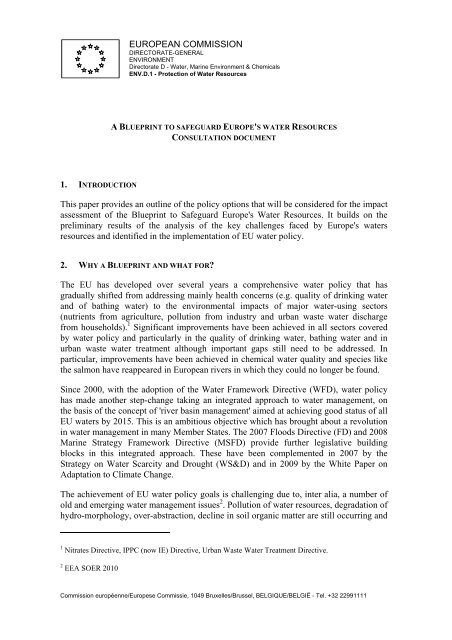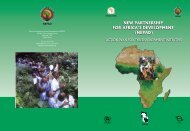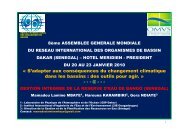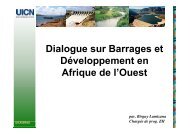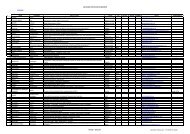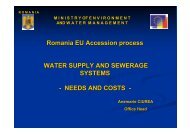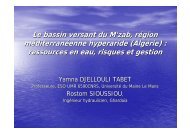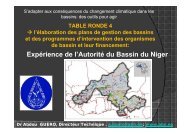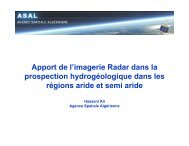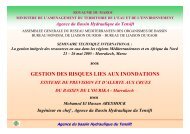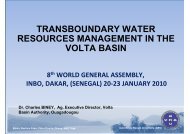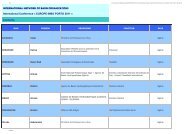background consultation document - European Commission - Europa
background consultation document - European Commission - Europa
background consultation document - European Commission - Europa
Create successful ePaper yourself
Turn your PDF publications into a flip-book with our unique Google optimized e-Paper software.
EUROPEAN COMMISSION<br />
DIRECTORATE-GENERAL<br />
ENVIRONMENT<br />
Directorate D - Water, Marine Environment & Chemicals<br />
ENV.D.1 - Protection of Water Resources<br />
A BLUEPRINT TO SAFEGUARD EUROPE'S WATER RESOURCES<br />
CONSULTATION DOCUMENT<br />
1. INTRODUCTION<br />
This paper provides an outline of the policy options that will be considered for the impact<br />
assessment of the Blueprint to Safeguard Europe's Water Resources. It builds on the<br />
preliminary results of the analysis of the key challenges faced by Europe's waters<br />
resources and identified in the implementation of EU water policy.<br />
2. WHY A BLUEPRINT AND WHAT FOR?<br />
The EU has developed over several years a comprehensive water policy that has<br />
gradually shifted from addressing mainly health concerns (e.g. quality of drinking water<br />
and of bathing water) to the environmental impacts of major water-using sectors<br />
(nutrients from agriculture, pollution from industry and urban waste water discharge<br />
from households). 1 Significant improvements have been achieved in all sectors covered<br />
by water policy and particularly in the quality of drinking water, bathing water and in<br />
urban waste water treatment although important gaps still need to be addressed. In<br />
particular, improvements have been achieved in chemical water quality and species like<br />
the salmon have reappeared in <strong>European</strong> rivers in which they could no longer be found.<br />
Since 2000, with the adoption of the Water Framework Directive (WFD), water policy<br />
has made another step-change taking an integrated approach to water management, on<br />
the basis of the concept of 'river basin management' aimed at achieving good status of all<br />
EU waters by 2015. This is an ambitious objective which has brought about a revolution<br />
in water management in many Member States. The 2007 Floods Directive (FD) and 2008<br />
Marine Strategy Framework Directive (MSFD) provide further legislative building<br />
blocks in this integrated approach. These have been complemented in 2007 by the<br />
Strategy on Water Scarcity and Drought (WS&D) and in 2009 by the White Paper on<br />
Adaptation to Climate Change.<br />
The achievement of EU water policy goals is challenging due to, inter alia, a number of<br />
old and emerging water management issues 2 . Pollution of water resources, degradation of<br />
hydro-morphology, over-abstraction, decline in soil organic matter are still occurring and<br />
1 Nitrates Directive, IPPC (now IE) Directive, Urban Waste Water Treatment Directive.<br />
2 EEA SOER 2010<br />
<strong>Commission</strong> européenne/Europese Commissie, 1049 Bruxelles/Brussel, BELGIQUE/BELGIË - Tel. +32 22991111
have detrimental impacts on freshwater ecosystems and on economic activity, in<br />
particular through the nexus between water, food and energy production. Demographic<br />
evolution, land use change and economic development are projected to increase pollution<br />
and water shortages. This is expected to be exacerbated by climate change, particularly in<br />
the Mediterranean region, while increasing the intensity and frequency of floods in many<br />
parts of Europe. All this makes it increasingly difficult to achieve the WFD objective of<br />
good water status for all EU waters by 2015.<br />
The Fitness Check of EU Freshwater Policy 3 and the assessment of the River Basin<br />
Management Plans 4 of the EU Member States conducted by the <strong>European</strong> <strong>Commission</strong> in<br />
2010-2012 show that the adequacy of the current water legislative framework is not<br />
questioned, nor is its coherence with the rest of environment policy. However, there exist<br />
fundamental weaknesses in the implementation of the current water legislation as well as<br />
conflicts between water policy and other EU policies' objectives.<br />
Improvements in implementation are the first priority. Member States need to meet their<br />
obligations under EU water law to ensure the instruments are effective and that the<br />
benefits of implementation can be realised. In relation to other policies, improved<br />
coherence is needed in particular with the Common Agriculture Policy (CAP) and with<br />
Regional Policy to ensure EU funds are better targeted at measures that deliver<br />
improvements to water and water law obligations are respected. Improved coherence is<br />
needed with renewable energy and transport policy to ensure that measures adopted for<br />
climate mitigation do not cause unintended negative impacts on water. Implementation<br />
can only be fully effective if all the inter-linkages between water policy, other areas of<br />
environmental policy and other policy areas outside environment are addressed.<br />
With a view to respond to the above challenges and ensure the achievement of EU water<br />
policy objectives, it is necessary to clarify whether and what additional actions and tools<br />
are needed at Member States and EU level.<br />
The Blueprint to Safeguard Europe's Water Resources will try to do this with the longterm<br />
aim to ensure availability of good quality water for sustainable and equitable<br />
water use in line with the WFD objective. The time horizon of the Blueprint is 2020<br />
since it is closely related to the EU 2020 Strategy and in particular to the recent Resource<br />
Efficiency Roadmap. The Blueprint will be the water milestone on that Roadmap.<br />
However, the analysis underpinning the Blueprint will in fact cover a longer time span up<br />
to 2050.<br />
Following the above analysis, the Blueprint will have 3 main foci:<br />
• First, improving the implementation of current EU water policy by making full use<br />
of the opportunities provided by the current framework;<br />
• Second, fostering the integration of water and other policies' objectives. Trade-offs<br />
should be managed on the basis of a better understanding of the costs and benefits of<br />
both economic activities and water resources management; and<br />
3 See http://ec.europa.eu/environment/water/blueprint/fitness_en.htm and http://ecologic-events.eu/Fitness-<br />
Check-Workshop/about<br />
4 See http://ec.europa.eu/environment/water/participation/map_mc/map.htm<br />
2
• When necessary, seeking the completion of the current policy framework, especially<br />
in relation to water quantity, efficiency and adaptation to climate change.<br />
The knowledge base for this work 5 is mainly provided by the assessment of the River<br />
Basin Management Plans under the Water Framework Directive; the Fitness Check of<br />
EU water policy; the review of the policy on water scarcity and drought; and several<br />
studies assessing the vulnerability of water resources to climate change and other man<br />
made pressures.<br />
The Blueprint, in line with the current approach of water policy, will propose EU action<br />
where it offers added value and will take fully into account the very significant<br />
differences between and within Member States in terms of water availability, quality,<br />
quantity, efficiency etc. Therefore, it will not put forward a one size fit all straight<br />
jacket but rather try to put in place the tool box that Member States can rely upon to<br />
improve water management at national, regional and river basin level.<br />
The Blueprint will set the agenda for EU water policy for the years to come, in particular<br />
for the Common Implementation Strategy (CIS) that brings together the <strong>European</strong><br />
<strong>Commission</strong>, Member States and stakeholders under the Water Framework Directive. On<br />
the basis of the assessments carried out so far in the Fitness Check, it will not suggest<br />
any fundamental overhaul of the current policy framework. Moreover, a full review and<br />
possible revision of the Water Framework Directive is legally required for 2019, after the<br />
results of its first implementation cycle will be available.<br />
3. HOW ARE POLICY OPTIONS BEING DEFINED IN THE BLUEPRINT?<br />
This paper is structured according to the five major themes expected to be covered by the<br />
Blueprint. It starts by considering what tools may be needed for the sustainable<br />
management of water resources (section 4). It then looks into ways of unlocking<br />
measures and relying on economic incentives to achieve such targets (sections 5 and 6).<br />
It finally focuses on governance and knowledge base as cross-cutting conditions for<br />
sound decision making and effective implementation (sections 7 and 8).<br />
For each theme the issues and problems relevant to that theme are introduced and all<br />
options are linked to the specific problems that they address. The 3 themes of<br />
implementation, integration and completion cut across virtually all the problems and sets<br />
of options. As this <strong>document</strong> is aimed at an open public <strong>consultation</strong>, the presence of<br />
an option on the list by no means imply that it is supported by the <strong>European</strong><br />
<strong>Commission</strong> at this stage.<br />
Policy options are distributed across the whole DPSIR cycle (Driving forces, Pressures,<br />
States, Impacts, Responses). They reflect different intensities and timescale ranging<br />
from options for actions which are process oriented, e.g. amending/developing a<br />
guidance <strong>document</strong> or undertaking further analysis, to possible amendments of existing<br />
legislation or enactment of new <strong>European</strong> legislation.<br />
5 See http://ec.europa.eu/environment/water/blueprint/index_en.htm. The <strong>Commission</strong> is planning to<br />
publish the final report on the Fitness Check in April. It is also planning to publish, together with the<br />
Blueprint, a report on the assessment of the river basin management plans of the Member States and a<br />
review of the policy on water scarcity and droughts.<br />
3
Options are not necessarily mutually exclusive and could often be combined or<br />
graduated over time. Water policy is such a crosscutting issue, relevant to many<br />
economic sectors, policy areas and geographical contexts, that the number of options<br />
under consideration is relatively high. The options presented here are already the result<br />
of a selection from a much broader list which has been narrowed down on the basis of<br />
the relevance and added value of the options considered, taking particularly into account<br />
the transboundary character of the majority of EU river basins. In the impact assessment<br />
of the Blueprint, the preliminary options presented below will be further packaged in a<br />
more limited set which can be assessed against its effectiveness in addressing EU water<br />
challenges as a whole.<br />
4. IMPROVING THE TOOLS FOR BETTER MANAGEMENT OF WATER RESOURCES<br />
The recently completed ClimWatAdapt project has modelled the water gap 6 between<br />
water demand and water availability in Europe in 2025 and 2050, combining climate<br />
change and socio-economic scenarios.<br />
Scenarios for water stress 2050<br />
Water Exploitation Index for the summer season and excluding water withdrawals for cooling power plants.<br />
FP6 SCENES Scenario «Economy<br />
First» 2050<br />
FP6 SCENES Scenario «Sustainability<br />
Eventually» 2050<br />
Source: DG Environment,<br />
ClimWatAdapt database, 2011<br />
Low stress (WEI < 20%)<br />
Medium stress (20% < WEI < 40%<br />
High stress (WEI > 40%)<br />
The main message from this bold exploratory exercise is that even with strong<br />
improvements in water efficiency in all sectors – in particular agriculture - water stress<br />
(water scarcity and droughts) would be a problem in numerous EU catchments, including<br />
6 See<br />
http://circa.europa.eu/Public/irc/env/wfd/library?l=/framework_directive/climate_adaptation/climwata<br />
dapt_report&vm=detailed&sb=Title<br />
4
in south, central, eastern and western Europe (see scenario on 'sustainability eventually'<br />
in the right map below). On the basis of a business as usual scenario ('economy first' in<br />
the left map), the areas potentially affected by water stress are much larger. This pleads<br />
for action to be taken on the basis of a more integrated analysis of the potential for<br />
increasing water availability, water retention, water efficiency and water savings taking<br />
fully into account the uncertainties linked to economic developments in various sectors<br />
and climate change.<br />
In the context of the Blueprint, refining the result of ClimWatAdapt, a baseline scenario<br />
is being developed bringing together climate, land-use and socio-economic scenarios and<br />
looking at the implication for water resources availability and use under business-asusual.<br />
Different policy scenarios with concrete measures (see section 5 below) will be<br />
evaluated against this baseline which puts together water quantity and water quality<br />
aspects, and builds on the information reported by the Member States in the River Basin<br />
Management Plans (RBMPs).<br />
The Water Framework Directive (WFD) goal of achieving good status includes both<br />
qualitative and quantitative aspects. Water quantity is explicitly addressed for<br />
groundwater and is implicit for surface water as a minimum environmental flow is<br />
necessary to achieve good ecological status. However, there is, at the moment, no<br />
common definition and application of the concept of environmental flows (E-Flows) i.e.<br />
the quantity of water that nature needs for the good ecological status to be achieved and<br />
the provision of ecosystem services to be maintained.<br />
The establishment of water balances and of targets on quantitative water management<br />
only takes place in a few river basins. Water stress indicators and targets developed and<br />
applied at river basin level to improve water efficiency could help prioritising and<br />
optimizing water uses and look at alternatives provided that a consistent approach is<br />
taken in particular in the transboundary river basins. However, target setting for<br />
(quantitative) water resource management is hampered by the failure of the current set of<br />
water quantity indicators to provide an adequate picture of the gap between water<br />
resources use and availability. Currently, most data are based on annual and country level<br />
statistics giving averages that do not reflect the situation at river basin level. Early efforts<br />
by the EEA to create water balances at sub-catchment level also face the problem of lack<br />
of reliable data and methodologies for water efficiency target setting.<br />
While the above-mentioned water efficiency targets could bring about significant<br />
improvements in water management in water scarce areas, additional action may be<br />
needed to face extreme weather phenomena such as droughts to increase preparedness<br />
and reaction capacity by better integrating them into overall water management. By<br />
2007, at least 11 % of Europe's population and 17 % of its territory had been affected by<br />
water scarcity, putting the cost of droughts in Europe over the past thirty years at EUR<br />
100 billion.<br />
Problem 1: Water balances and adequate water allocation are poorly implemented at<br />
river basin level. In many instances, river basin managers are not fully aware of how<br />
much water flows in and out of a river basin. Nor do they know how climate change will<br />
alter precipitation or how land use will affect groundwater recharge and therefore<br />
availability of water. Therefore, even when in charge of water allocation, they are unable<br />
to allocate the water resources efficiently or even fairly among water users including the<br />
5
asic needs for nature i.e. the environmental flows. This is both a water quantity and<br />
quality problem since good water status cannot be achieved without adequate water<br />
allocation.<br />
Options to address the problem:<br />
a) Develop guidance through a working group under the WFD Common<br />
Implementation Strategy to support the use of water accounting and E-Flows at river<br />
basin level (including specific tests in pilot river basins); to agree a methodology for<br />
efficiency target setting at river basin level; and to update reporting to the EC to<br />
include E-lows and river flows.<br />
b) Develop a Recommendation on the use of water accounting, efficiency target setting<br />
and environmental flows at river basin level and an indicative EU water efficiency<br />
target.<br />
c) Specific recommendations are considered for Member States on water accounting,<br />
efficiency target setting and environmental flows at river basin level in the context of<br />
the <strong>European</strong> Annual Growth Survey for the <strong>European</strong> Semester.<br />
d) Adopt technical annexes to the WFD on E-Flows that will require water accounting<br />
for river basins; specify the protocol for establishing E-Flows, making the use of the<br />
E-Flows definition compulsory in all water stressed river basins; and require the<br />
setting up of water efficiency targets on the basis of an agreed methodology.<br />
Problem 2: Droughts have been more frequent and severe in large parts of Europe in the<br />
last few years, and the severity and frequency is expected to increase in the future as a<br />
result of climate change, changes in land use and water abstraction. This has and will<br />
have important social, economic and environmental consequences for the affected<br />
Member States.<br />
Options to address the problem:<br />
a) Enhance drought management planning into the next cycle of River Basin<br />
Management Plans under the Water Framework Directive for all droughts<br />
affected/potentially affected Member States.<br />
b) Develop a <strong>European</strong> wide early warning system for droughts to timely alert Member<br />
States on the need to take counter-measures.<br />
c) Establish a drought emergency fund which would group in a single instruments and<br />
enhance the funding possibilities currently available under the EU Solidarity Fund and<br />
rural development funding. The Fund would include appropriate conditionalities on<br />
drought prevention measures being taken.<br />
d) Establish a drought management directive to require Member States to develop and<br />
implement river basin drought management plans with specific drought measures to be<br />
reported to the <strong>Commission</strong>.<br />
6
5. UNLOCKING MEASURES IN KEY SECTORS<br />
In order to deliver objectives and targets for Europe’s waters, a range of different<br />
measures in key policy sectors can be considered at EU level to improve water resource<br />
efficiency and sustainability.<br />
Some of these measures will need to be unlocked trough innovative process. This task<br />
will be taken up, in particular, by the <strong>European</strong> Innovation Partnership (EIP) on<br />
Water that will complement the Blueprint by integrating in its Strategic Implementation<br />
Plan the policy recommendations identified by the Blueprint. The EIP on Agricultural<br />
Productivity and Sustainability will also play an important role in this regard, especially<br />
by promoting innovation at farm level.<br />
The impact assessment of the Blueprint will focus on measures for which – while not<br />
necessarily being innovative - there is a need to better understand the costs and benefits,<br />
the trade-offs and synergies with other policies, as well as their contribution to a greater<br />
resilience of environment and society to climate variability and change. Such measures<br />
fall within 3 categories exemplified by the picture here below: 1. Managing water<br />
demand; 2. Protecting water ecosystems; 3. Improving availability of clean water. They<br />
cover water qualitative and quantitative aspects which are inextricably linked.<br />
Improvement of irrigation<br />
systems and management<br />
Managing water<br />
demand<br />
efficiency measures at the buildings<br />
level<br />
water efficient products<br />
Protecting the<br />
water<br />
ecosystems<br />
Restoring<br />
longitudinal<br />
continuity<br />
Crop<br />
management<br />
Soil<br />
management<br />
Reducing water pollution<br />
at source<br />
Restoring<br />
riparian area<br />
Restoring lateral<br />
connectivity<br />
Distribution<br />
networks<br />
Water reuse<br />
& recycling<br />
Water storage<br />
Treatment of<br />
brackish or<br />
sea water<br />
Transfers<br />
Improving<br />
availability of<br />
clean water<br />
7<br />
A number of measures relate to land use, be it in relation to urban, industrial or<br />
agriculture activities. Land use planning and management, if it does not factor in water<br />
policy objectives, could have major negative effects on water, including pollution,<br />
7 Longitudinal continuity of a river is hindered when a physical barrier to the flow, e.g. a dam, is put in<br />
place that prevents the movement of fish and other aquatic organisms. Lateral connectivity is the<br />
connection between the river and its natural floodplain that may be interrupted by, e.g., embankments.<br />
A riparian area is the interface between land and a river or stream.<br />
7
interruption of river continuity (e.g. dams) or connectivity with the rest of the land (e.g.<br />
dykes or embankments).<br />
In this respect agricultural activity stands out as a major pressure on water quality and<br />
quantity as the sectors is Europe's biggest land user/owner, a big water user 8 as well as<br />
the biggest water consumptive user 9 . Agricultural impacts include eutrophication due to<br />
fertilisers, contamination by pesticides, soil erosion and hydromorphological changes in<br />
the majority of river basins. Measures to address such impacts involve a more sustainable<br />
use of fertiliser and pesticide inputs, maintaining soil organic matter levels, changing<br />
crop patterns, enhanced use of buffer strips, improved irrigation practices, wetland<br />
restoration, restoration of riparian areas, etc. Some of these measures address impacts<br />
which are directly or indirectly covered by the WFD objective of good ecological status,<br />
and therefore are often found in the RBMPs reported by Member States. However,<br />
preliminary assessments indicate that the uptake of some of the key measures, in<br />
particular those related to some of the most innovative elements introduced by the WFD<br />
such as hydromorphology, is not sufficient to achieve a sustainable situation.<br />
In water stressed/potentially stressed areas, water efficiency measures are also required<br />
in relation to distribution networks, where large amounts of water continue to be wasted<br />
through leakages, and in buildings, where the water using appliances or the design of the<br />
building is not promoting water savings. This causes a considerable waste of water and<br />
energy used to heat the water. Heating water constitutes 15%-30% of the household<br />
energy demand.<br />
Waste water re-use has the potential to contribute to the irrigation requirements of<br />
agriculture in some river basins or to industrial uses provided that all relevant safety<br />
standards are respected. However, there are no EU level standards for water re-use and<br />
some Member States are adopting/have adopted their own standards while others have<br />
not done so. Without common EU standards, a potentially significant source of water is<br />
not being tapped into and an adequate soil and water protection may not be guaranteed.<br />
Moreover, there is a potential for some Member States to object to products grown with<br />
reused water in other Member States thereby generating an obstacle to the internal<br />
market. In addition, the water industry needs certainty for future use to make the<br />
necessary investments to enable water re-use and respect safety standards.<br />
Problem 3: Land use impacts and in particular agriculture's impacts threaten water<br />
quality and quantity across much of Europe and deregulate water flow increasing water<br />
scarcity and flood risks.<br />
Options to address the problem:<br />
a) The <strong>Commission</strong> to develop guidance clearly defining and providing a EU<br />
framework for green infrastructures that promotes natural water retention measures<br />
8 24% of total water abstraction in Europe, up to 80% of total water abstraction in southern Europe Europe<br />
(EEA, 2009, Water resources across Europe — confronting water scarcity and drought).<br />
9 Around 70% of water used in agriculture is consumed and not returned to the environment Europe (EEA,<br />
2009, Water resources across Europe — confronting water scarcity and drought).<br />
8
such as floodplains and wetlands restoration; sustainable drainage, the restoration of<br />
riparian areas and the re-meandering of rivers.<br />
b) The <strong>Commission</strong> to develop guidance for integrated water – land use management,<br />
bringing together spatial planning and RBMPs in co-ordination with other aspects of<br />
EU environmental policy (biodiversity, nature, soil).<br />
c) Develop guidance trough the agriculture working group under the WFD Common<br />
Implementation Strategy on the effective application of measures by farmers to<br />
deliver water quality and quantity objectives at catchment level. These measures<br />
include changing crop patterns, buffer strips, restoring riparian areas, increase<br />
irrigation efficiency, etc. In that respect, particular emphasis will be put on the use of<br />
the Farm Advisory System set up under the CAP.<br />
d) The <strong>European</strong> Innovation Partnership on Agricultural Productivity and Sustainability<br />
and the <strong>European</strong> Innovation Partnership on Water develop and disseminate<br />
innovative solution to ensure agriculture's negative impact on water are removed or<br />
minimised and beneficial effects are maximised.<br />
e) Enhance the application of Environmental Impact Assessment to irrigation projects.<br />
f) Enlarge the scope of the Strategic Environmental Assessment Directive to cover all<br />
hydropower development plans.<br />
g) The <strong>Commission</strong> to ensure that the implementing rules for the post-2013 CAP I and<br />
II pillars support and target the necessary measures to deliver water quality and<br />
quantity objectives. 10<br />
Problem 4: The design of building and water using appliances does not sufficiently<br />
factor in water efficiency. This causes water waste that could be up to 10% or more of<br />
water consumption which is problematic in areas which are water stressed or at risk of<br />
becoming water stressed. It also causes a waste of energy used to heat the water.<br />
Options to address the problem:<br />
a) Voluntary labelling of water using appliances<br />
b) Mandatory labelling of water using appliances<br />
c) Establish a WFD Common Implementation Strategy working group on water use<br />
efficiency for preparing “BREF-like” notes on water use/conveyance efficiency.<br />
d) Minimum water efficiency requirements for water using appliances, e.g. under the<br />
Ecodesign directive<br />
e) Voluntary performance rating for buildings<br />
10<br />
This option is without prejudice to the on going discussion in the Council of Ministers and <strong>European</strong><br />
Parliament on the reform of the Common Agriculture Policy proposed by the <strong>European</strong> <strong>Commission</strong>.<br />
9
f) Mandatory performance rating for buildings<br />
g) Minimum water performance requirements for buildings<br />
h) A directive on water efficiency requirements in buildings including a requirement on<br />
water companies to reduce final water consumption<br />
Problem 5: Significant leakage in water infrastructure in some parts of the EU causes<br />
significant waste of water which is problematic in areas which are water stressed or at<br />
risk of becoming water stressed. As much as 50% of water abstracted is lost in<br />
distribution but with significant differences between Member States.<br />
Options to address the problem:<br />
a) Promote leakage reduction in water stressed/potentially water stressed areas by<br />
prioritising it in the use of Cohesion and Structural Funds.<br />
b) Promote leakage reduction investment on the basis of public/private partnerships,<br />
Eurobonds and/or <strong>European</strong> Investment Bank loans.<br />
c) Develop guidance on best practices in leakage reduction.<br />
d) Develop a harmonised method for determining the level of water leakage under the<br />
WFD Common Implementation Strategy at EU level and encourage Member States to<br />
integrate it into their water management.<br />
Problem 6: The lack of common EU standards for waste water re-use for agriculture and<br />
industrial uses limits a potentially important alternative water source (especially for<br />
water stressed areas), threatens farmers exporting crops within the single market and<br />
prevents industry from making long-term investment decisions. Moreover, an adequate<br />
soil and water protection may not be guaranteed.<br />
Options to address the problem:<br />
a) Develop EU guidance on certification schemes for water re-use<br />
b) The Comité Européen de Normalisation (CEN) to adopt standards for use of recycled<br />
waste water in agriculture.<br />
c) An EU Regulation establishing standards for waste water re-use.<br />
N.B. All options above would need to fully respect relevant public health (e.g. food<br />
safety) and environmental standards.<br />
6. ECONOMIC INSTRUMENTS<br />
On the basis of the analysis of the RBMPs and the review of Water Scarcity and<br />
Drought, the following findings have emerged.<br />
10
Current water pricing levels and structure do not provide sufficient incentives to increase<br />
water efficiency (this includes the identification of subsidies e.g. in energy and<br />
agriculture). In some cases, water users are either not charged at all or are not charged in<br />
relation to the quantity of water used.<br />
There are still gaps in the quantification of environmental and resource costs, which are<br />
often linked to the quantification (and when possible monetization) of the benefits of<br />
ecosystem services. This prevents the development of tools such as 'Payments for<br />
Ecosystem Services schemes' linked to reduced water resource depletion or land-use<br />
changes, which may result in cost-effective solution for the achievement of WFD<br />
objectives and other environmental or climate objectives. In many cases there is likely to<br />
be a strong economic argument for adopting water protection measures. Therefore, it is<br />
appropriate that Member State authorities are provided with the tools to understand their<br />
benefits and so be able to judge this against arguments of cost.<br />
Currently, water allocation schemes, where they exist, are often inefficient for the<br />
reasons explained in section 4 above on tools. The assessment and distribution of water<br />
rights may be linked to charging and, in order to foster more efficient water use, an<br />
economic instrument such as water rights trading may be used. However, water trading<br />
schemes only work if the spatial distribution of trading does not cause an environmental<br />
problem i.e. when the overall allocation of water rights in a given river basin does not put<br />
at risk the e-flow. Thus such schemes are only practical at river basin scale (and<br />
potentially at even smaller scales), but can be supported by EU level action.<br />
Many economic instruments cannot be introduced or work effectively if certain<br />
conditions are not met. Any charging scheme for water use requires accurate metering of<br />
that use and, therefore, expansion of metering will be needed. Illegal abstraction is a big<br />
problem in some basins. Being illegal, new law is not required but strong enforcement is<br />
needed (see ‘governance’ below).<br />
Problem 7: Absence of metering for individual users is a key barrier for the effective<br />
implementation of pricing schemes that incentivise water efficiency. Illegal abstraction in<br />
some parts of the EU is a large phenomenon that puts at risk water availability.<br />
Options to address the problem:<br />
a) Mapping all EU large irrigated areas via the GMES initiative and match these areas<br />
with water abstraction permits to help Member States enforce them and tackle illegal<br />
abstraction.<br />
b) Making EU funding for irrigation projects conditional upon the installation of<br />
metering devices for individual users e.g. via the CAP implementing rules. 11<br />
c) Making CAP direct payments to farmers (pillar I) conditional upon the installation of<br />
metering devices for individual users e.g. via cross compliance rules for the WFD. 12<br />
11 This option is without prejudice to the on going discussion in the Council of Ministers and <strong>European</strong><br />
Parliament on the reform of the Common Agriculture Policy proposed by the <strong>European</strong> <strong>Commission</strong>.<br />
11
d) Amend the WFD to make it explicit that the Art.11 requirement of a permit for water<br />
abstraction also includes mandatory metering of the quantities abstracted.<br />
e) Amend the WFD to require metering of individual water consumption and/or use<br />
where relevant.<br />
Problem 8: Current water pricing levels and structure do not provide adequate incentives<br />
to increase water efficiency. This includes the identification of subsidies e.g. in bioenergy<br />
and agriculture, which is a big water user as well as the biggest water<br />
consumptive user. In some cases, water users are either not charged at all or are not<br />
charged in relation to the quantity of water used/consumed.<br />
Options to address the problem:<br />
a) Implement the proposed rules for Cohesion & Structural and Rural Development<br />
funds to make the establishment of incentive pricing compulsory for (relevant)<br />
projects in areas with water deficit.<br />
b) Add national water pricing obligations for farmers, based on Art.9 of the WFD, to<br />
cross-compliance rules under the CAP for the WFD.<br />
c) The <strong>Commission</strong> to promote the use of trading in water rights at river basin level<br />
through the development of guidance and tools under the WFD Common<br />
Implementation Strategy.<br />
d) The <strong>Commission</strong> to develop criteria for the sustainable production of bio-energy<br />
crops with specific reference to water protection.<br />
e) Specific recommendations are considered for Member States on water pricing<br />
policies in the context of the <strong>European</strong> Annual Growth Survey for the <strong>European</strong><br />
Semester.<br />
f) Amend the WFD to require that the price of water reflects volumetric use.<br />
N.B. The above options should be seen as complementary to and not a replacement of the<br />
enforcement of the current provision on incentive pricing under article 9 of the WFD.<br />
Problem 9: Costs and benefits of inaction and of water related measures are not properly<br />
understood or quantified. There is a lack of a methodology to calculate the adequate<br />
recovery of environmental and resource costs, which prevent a further implementation of<br />
economic instruments for water resources management.<br />
Options to address the problem:<br />
12 This option is without prejudice to the on going discussion in the Council of Ministers and <strong>European</strong><br />
Parliament on the reform of the Common Agriculture Policy proposed by the <strong>European</strong> <strong>Commission</strong>.<br />
12
a) The WFD Common Implementation Strategy to develop guidance for the next cycle or<br />
RBMPs and a methodology for the calculation of an adequate contribution of the<br />
different water uses to the recovery of the costs of water services, including<br />
environmental and resource costs and ecosystem services' benefits.<br />
b) The <strong>Commission</strong> to propose an amendment of the WFD (an Annex) containing a<br />
mandatory methodology for the calculation of an adequate contribution of the different<br />
water uses to the recovery of the costs of water services, including environmental and<br />
resource costs and ecosystem services' benefits.<br />
7. GOVERNANCE<br />
Effective governance is necessary to deliver the implementing of existing and any new<br />
policies that might be included in the Blueprint. EU level action to influence water<br />
governance in Member States is not an objective in itself – rather it may be needed to<br />
support other policy objectives while respecting the principle of subsidiarity.<br />
Importantly, ineffective governance will undermine attempts to enhance target setting,<br />
unlocking specific technical measures and the application of some economic incentives.<br />
The Fitness Check has highlighted the role that implementation failure plays in<br />
undermining the effectiveness of EU water policy. In concrete terms, this focused on<br />
implementation failures of transposition, interpretation and delivery of specific planning<br />
or operation requirements of Directives. The appropriate <strong>Commission</strong> response of<br />
infringement action against Member States is also highlighted in the Fitness Check. It is<br />
also appropriate to highlight it as a key ‘strand’ in the Blueprint. In addition, many of the<br />
options presented in the previous sections have suggested ways to improve<br />
implementation.<br />
However, there are also much wider concerns over effective water governance. These<br />
have been highlighted within the analysis of RBMPs and Water Scarcity and Droughts<br />
(WSD) Gap Analysis. These include concerns of fragmented institutional structures, poor<br />
intra and inter-institutional relationships and capacity (personnel, technical capacity,<br />
training, etc.) which undermine the ability of authorities to perform the detailed analyses<br />
necessary to implement the WFD, perform the necessary monitoring, develop and<br />
implement RBMPs and develop amended plans in an effective adaptive management<br />
framework. Moreover, it has proven often difficult for MS to remove or change water<br />
rights/concession which have been in place for a long time. Such rigidity in the<br />
concessional system may hinder the efficient allocation of water resources. Furthermore,<br />
the current financial crisis is impacting on the budgets (and capacity) of governmental<br />
bodies across the EU with unknown consequences for water governance.<br />
There is also a particular issue with governance of transboundary river basins. There are<br />
positive examples of co-operative assessment and planning, but this is not the case across<br />
the whole of the EU and more coordination and joint planning in transboundary river<br />
basins are necessary as evidenced by the RBMPs assessment.<br />
Problem 10: Governance of water and sectoral policies at MS level is, in some cases,<br />
fragmented and faces a lack of capacity and resources to fully address water management<br />
objectives. There is lack of coordination in river basin shared between different<br />
13
administrative entities within Member States, between Member States and with third<br />
countries.<br />
Options to address the problem:<br />
a) On the basis of the <strong>Commission</strong> assessment of the RBMPs, the WFD Common<br />
Implementation Strategy to identify and disseminate best practices in the EU.<br />
b) To develop a peer review process for river basin district authorities within the context<br />
of the WFD Common Implementation Strategy with a view to help them identifying<br />
ways of improving their coordinating role.<br />
c) Specific recommendations are considered for Member States on water governance in<br />
the context of the <strong>European</strong> Annual Growth Survey for the <strong>European</strong> Semester.<br />
d) Develop initiatives on inspections and surveillance to improve the means of detecting<br />
and responding to water-related implementation problems such as over-abstraction. 13<br />
e) Continue to promote the river basin management approach and the implementation of<br />
the EU water acquis through EU enlargement policy and international rivers agreements.<br />
f) To amend the WFD to strengthen the coordination powers of River Basin District<br />
authorities and the obligations for combined RBMPs in transboundary contexts.<br />
8. KNOWLEDGE SHARING AND RESEARCH<br />
EU Water Policy is an adaptive framework where measures are based on detailed<br />
analysis and require refining through a cyclical planning process. This is only possible on<br />
the basis of detailed and up to date information about a wide range of issues.<br />
Improved knowledge is the focus of a number of options developed in the earlier sections<br />
(e.g. lack of specific data for target setting or cost/benefit analysis).<br />
In addition to enhancing the knowledge base as such, there is also a need to improve<br />
knowledge sharing. As about 60% of the river basins covered by EU water policy are<br />
transboundary, it is essential to have an effective knowledge sharing system between<br />
Member States, <strong>European</strong> bodies and third countries with whom the EU shares such<br />
basin or inconsistent policies may be developed. For knowledge to be shared effectively,<br />
inter-operability of data bases based on the INSPIRE Directive and the Share<br />
Environmental Information System (SEIS) principles is needed. The Global Monitoring<br />
for Environment and Security (GMES) initiative can contribute with specific data and<br />
information.<br />
In order to respond to emerging and future knowledge needs, it is also necessary to<br />
identify research priorities for the next research funding period and improving the<br />
science policy interface.<br />
13 See responsiveness section of the <strong>Commission</strong>'s Communication COM (2012) 95, "Improving the<br />
delivery of the benefits from EU environment measures: building confidence through better<br />
knowledge and responsiveness"<br />
14
Problem 11: There is insufficient dissemination and sharing of compatible data and<br />
other information between Member States, <strong>European</strong> bodies and third countries leading<br />
to an incomplete understanding of the problems facing Europe’s waters or, potentially, to<br />
incoherent water management choices. Data provision is not timely and different systems<br />
prevent data access. New and emerging knowledge needs must be addressed trough<br />
research activities.<br />
Options to address the problem:<br />
a) Improve the sharing of data and other information by further developing the Water<br />
Information System for Europe (WISE) Implementation Plan.<br />
b) Enhance minimum WFD reporting requirements and statistical obligations (e.g.<br />
trough framework regulations on environmental accounts & statistics), especially<br />
with regard to inter-operability of data. This includes harmonising the reporting<br />
timetables of the Urban Waste Water Treatment, Nitrates and Water Framework<br />
Directives.<br />
c) Develop a fully inter-operable, SEIS based, shared water knowledge system,<br />
reducing reporting requirements while prescribing interoperability standards for the<br />
information produced at local and national level and through GMES. 14<br />
d) Develop a roadmap for water research priorities to be integrated in the next research<br />
funding cycle at EU and Member States level taking into account the need to improve<br />
the science policy interface.<br />
9. GLOBAL ASPECTS<br />
The options included in the previous sections related to the EU and the neighbouring<br />
countries with which it shares transboundary river basins, since this is the main<br />
geographical focus of the Blueprint.<br />
At global level, the EU is committed to the achievement of the Millennium Development<br />
Goals (MDGs) of halving by 2015 the proportion of the population without sustainable<br />
access to safe drinking water and basic sanitation and is actively involved in the<br />
preparation of the Rio+20 Conference (June 2012).<br />
In addition to the need to satisfy basic human needs related to water, another major<br />
global problem concerns water availability. As recent studies show, "Competing<br />
demands for scarce water resources may lead to an estimated 40% supply shortage by<br />
2030". 15<br />
14 See knowledge section of the <strong>Commission</strong>'s Communication COM (2012) 95, "Improving the delivery<br />
of the benefits from EU environment measures: building confidence through better knowledge and<br />
responsiveness"<br />
15 Charting our Water Future, McKinsey 2010.<br />
15
The EU can contribute to addressing this problem by supporting integrated water<br />
management in developing countries in its development cooperation policy (e.g. via a<br />
renewed EU Water Initiative). This is particularly important if one considers the virtual<br />
flow of water embedded in traded agricultural and industrial products. Both virtual water<br />
importers and exporters share the responsibility of not depleting water resources in the<br />
exporting countries. Mismanagement and wastage of water in water scarce countries<br />
could have very negative consequences on local development and even be the cause of<br />
migration flows. Therefore, the development of sustainable water management in the<br />
exporting countries, e.g. by increasing water efficiency and improving the choice of<br />
crops and other products, seems the most promising option.<br />
While the EU already has in place a framework for the sustainable management of water,<br />
the issue of virtual water is not only of global relevance but is also important within the<br />
EU, in relation to water balances (section 4. above) for agricultural and industrial<br />
products. Therefore options b) to d) below are also relevant within the EU.<br />
Problem 12: Competing demands for scarce water resources may lead to an estimated<br />
40% supply shortage by 2030. Mismanagement and wastage of water in water scarce<br />
countries could have very negative consequences on local development and even be the<br />
cause of migration flows from developing countries.<br />
Options to address the problem:<br />
a) Help developing countries to put in place integrated sustainable water management<br />
trough EU development cooperation.<br />
b) Raise consumers' awareness of the water footprint of products.<br />
c) Keep under review water foot printing tools with a view to test their usefulness for<br />
voluntary product labelling (e.g. as part of EU Ecolabel).<br />
d) Mandatory labelling of most embedded water intensive products.<br />
.<br />
16


